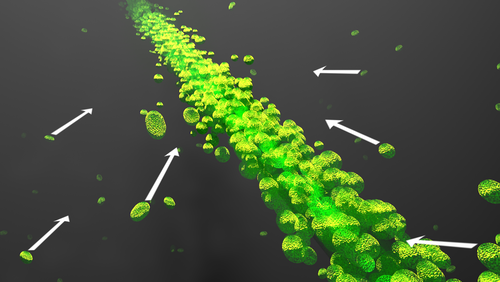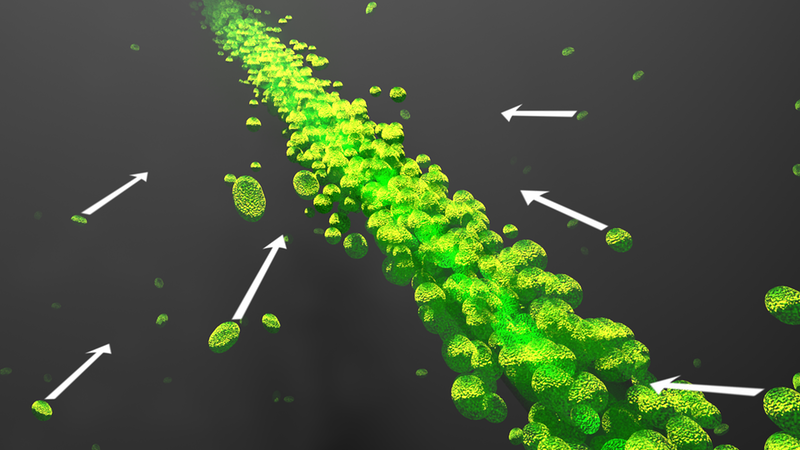Bacteria Form Waveguides
Floating in nearly any sea or lake are bacteria that scatter sunlight and help darken the deep. But if you shine a strong laser beam into the water, those same bacteria can increase light transmission compared with plain water by assembling into a light-channeling waveguide. A research team has now detected this so-called self-focusing effect not only in marine bacteria but also in other bacteria and in blood cells. Further efforts at controlling the effect could open up new ways of imaging biological samples.
Soft-matter physicists want to use light to manipulate concentrations of objects, such as nanoparticles or microorganisms, suspended within a fluid. This control could, for example, drive chemical or biological reactions within the system. One phenomenon that may help or hinder these efforts is self-focusing, a nonlinear effect that typically occurs when the suspended particles have an index of refraction that is higher than the surrounding fluid. As a light beam passes through, the particles are drawn toward its high-intensity center by the so-called optical gradient force. The resulting high concentration of high-index particles along the beam axis acts like a lens that can cause the beam to “collapse” to a point, out of which the light scatters in many directions. However, Zhigang Chen from San Francisco State University (SFSU) and his colleagues used polymer-based nanoparticle suspensions to demonstrate in 2013 that they could prevent collapse and instead use the particles to create a narrow beam called a needle of light [1].
Self-focusing was not thought to be relevant for biological cells. Their index of refraction is very similar to that of the water that surrounds them, so the optical gradient force should be weaker in bacteria than in nanoparticles, Chen says. To increase the force, one could ramp up the light intensity, but that could risk “cooking” the cells, says SFSU team member Anna Bezryadina. Despite these uncertainties, she, Chen, and their colleagues looked for self-focusing with a type of cyanobacteria called Synechococcus, which is found in many ocean environments. Unlike some microorganisms that swim toward light, bacteria from the strain the team chose can’t move on their own.
The team placed various concentrations of bacteria in a 4-centimeter-long tube filled with seawater and for each sample sent in a green laser beam with an initial width of 50 micrometers. With no bacteria present, the beam broadened out to 650 micrometers, mainly due to normal diffraction. Once bacteria were added, two possibilities occurred depending on the laser power. At low power (0.1 watts), scattering by the cells caused the final beam to double in width to 1.25 millimeters. But at higher power (3 watts), the beam formed a needle with a width of roughly 200 micrometers. About 10% of the incoming beam was transmitted all the way through—more than the team observed with nanoparticle suspensions.
To explain this behavior, the researchers constructed a theoretical model that included not just the optical gradient force but also a force due to the radiation pressure of light. This latter force, which pushes objects in the direction of the beam, has a small effect on nanoparticles. But bacteria scatter more light because they contain internal cell structures, so they experience greater radiation pressure. The team showed in simulations that the combination of forward push and inward pull causes the bacteria to concentrate into a thin “fiber,” which prevents the beam from spreading out.
Regarding the bacteria’s health, the team was surprised that the mortality rate in the light-exposed groups was only 0.1% greater than in a control group. The researchers found similar light needles in suspensions containing E. coli bacteria and human red blood cells. The implication is that self-focusing might be used to transmit energy or information through normally opaque biological materials. For example, one might be able to perform noninvasive medical diagnostics with light beams that can induce self-focusing in a sample, Bezryadina says.
“The most important result is the fact that bacteria remain alive in the nonlinear interaction with light,” says optics expert Claudio Conti from the National Research Council (CNR) in Rome. This opens up the possibility—not addressed in the paper—that the cells are interacting with each other in a way that influences their light-responsive behavior. “The published paper is certainly a milestone that will stimulate much further work in a newborn and very relevant direction in modern nonlinear optics,” Conti says.
This research is published in Physical Review Letters.
–Michael Schirber
Michael Schirber is a Corresponding Editor for Physics Magazine based in Lyon, France.
References
- W. Man, S. Fardad, Z. Zhang, J. Prakash, M. Lau, P. Zhang, M. Heinrich, D. N. Christodoulides, and Z. Chen, “Optical Nonlinearities and Enhanced Light Transmission in Soft-Matter Systems with Tunable Polarizabilities,” Phys. Rev. Lett. 111, 218302 (2013).





